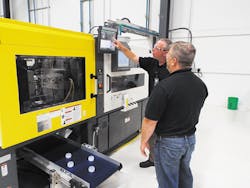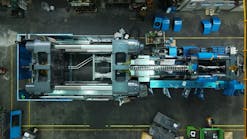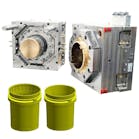A new method for making high-quality injection molded parts using dramatically lower pressures and clamping forces now is commercially available from Procter & Gamble subsidiary Imflux.
The process, also called Imflux, results in faster cycle times, lighter parts, improved part surfaces and the ability to run molds in smaller presses than would typically be needed, according to Gene Altonen, CTO and inventor of the Imflux technology.
Imflux equipment is retrofittable to fully hydraulic, servo-hydraulic and all-electric molding machines from a wide variety of manufacturers. It includes a proprietary control system equipped with software that communicates with the injection molding machine and the mold to control injection in a closed-loop manner. The software is compatible with kits supplied by OEMs that allow their equipment to interface with third-party controllers.
Two sensors are required. The first is an off-the-shelf pressure sensor placed in the nozzle of the press. The second sensor can either be an off-the-shelf cavity-pressure sensor that is placed in the mold, or Imflux's new Nighthawk strain sensor, which is placed on the outside of the mold.
The second sensor monitors both cavity pressure and progression of the flow front; even in a multicavity tool, just one sensor is required for this part of the process, Altonen said. The sensors are vital because they provide real-time feedback from the mold and also make it possible for the machine to automatically adjust the melt velocity by changing the screw velocity.
"If the material hesitates, the Imflux process may produce a short shot or quality defect," Altonen said. Therefore, Imflux controls the screw's forward movement to maintain a desired pressure setpoint that results in a non-hesitating flow of polymer.
The system can actuate sequential valve gates based on position of the melt, compensate for blocked cavities and operate without being affected by a leaky check ring or worn barrel.
However, limitations of the press can impair the process. "If a press is velocity-limited, it can restrict the ability of the press to build pressure to achieve a desired setpoint," Altonen said.
PRESSURE, NOT VELOCITY, IS KEY
Imflux is a departure from conventional injection molding, in which the material velocity is controlled and the pressure varies as the melt encounters different geometries inside the mold cavity. That variation in pressure can lead to uneven material shrinkage across a part and from one cavity to another.
The injection pressure typically required when using Imflux is 30 percent to 60 percent lower than the peak injection pressure in a conventional pack-and-hold molding process. One major benefit of controlling the process via melt pressure is that knit lines are stronger because the split melt fronts are rejoined under similar pressures and low velocities.
Conventional injection molding generally fills the mold with material as quickly as possible to take advantage of the shear-thinning properties of a polymer and to minimize material freeze-off. However, high-speed filling creates more material shearing and, thus, higher material temperatures, and the need for higher clamping pressures to counter high melt pressure.
The system measures melt pressure in the machine nozzle, then provides closed-loop control of the injection process to achieve optimal filling conditions.
"Imflux controls the injection process based on plastic melt pressure. Additional parameters are monitored for quality and control purposes, including screw position, screw velocity, melt temperature and hydraulic pressure," Altonen said.
SIMULTANEOUS FILLING, COOLING AND PACKING
The constant pressure uniformly advances the melt flow front, even where it encounters features such as a rib or boss. But despite a slower filling rate, the technology can produce shorter cycle times.
The lower pressure and slower melt velocity impart less friction on the polymer as it fills the mold so the surface of the polymer in contact with the mold cools rapidly.
"This results in the material packing/solidifying as the mold is filled," Altonen said. The pack-and-hold step, a requirement in conventional molding, is dramatically reduced with Imflux.
Part weight is reduced without changing the part's design, because the mold is packed more evenly, and overpacking can be reduced. Typically, Imflux produces parts that weigh 1 percent to 3 percent less.
At the same time, the lower molding pressures required by Imflux provide the ability to reduce part wall thickness, Altonen said.
To use the process, Imflux experts work with users to define the optimal pressure range for a given molding system, and the optimal processing window within this range to produce the part with the desired part quality, Altonen said. Algorithms within the Imflux control software accommodate a broad range of materials, molding systems and injection press types in establishing the optimal pressure range, Altonen said.
YEARS OF DEVELOPMENT
P&G announced the development of Imflux in 2013, forming the stand-alone subsidiary that year to further develop and commercialize the technology. Imflux was born out of research P&G was conducting to produce molds more quickly. P&G is using Imflux within its own molding operations, and with its partners, to produce molded caps, closures, razors and many other consumer products.
Imflux has been used successfully to process dozens of polymer types, fillers, colorants and additives, and has been proven through hundreds of commercial applications since its inception. Imflux says the numerous applications confirm the benefits of the technology, including the trimming of cycle times by as much as a fourth and the ability to manufacture lighter parts with stronger weld lines, fewer sink marks and less flash.
Altonen cited a case study of a manufacturer that was experiencing short shots in the production of a PP medical part made in a 16-cavity mold with a valve-gated hot-runner system. By using Imflux, the molder realized more uniform filling from cavity to cavity. This reduced the scrap rate from over 10 percent to less than 0.2 percent. Altonen would not discuss specific commercial applications because they are the subject of non-disclosure agreements.
When it comes to mold making, Imflux can be used with a range of tool steels, and, in some cases, can be compatible with softer metals, such as aluminum and beryllium copper. The company can supply the mold, but the process can work with molds made by outside vendors. And part designers have more options for gate placement, such as at a thin-to-thick area of the part, Altonen said.
Mikell Knights, senior staff reporter
Contact:
Contact: Imflux Inc. Hamilton, Ohio, 513-488-1017,
Plastics Hall of Fame seeks nominees
Amcor, Berry Global will merge







